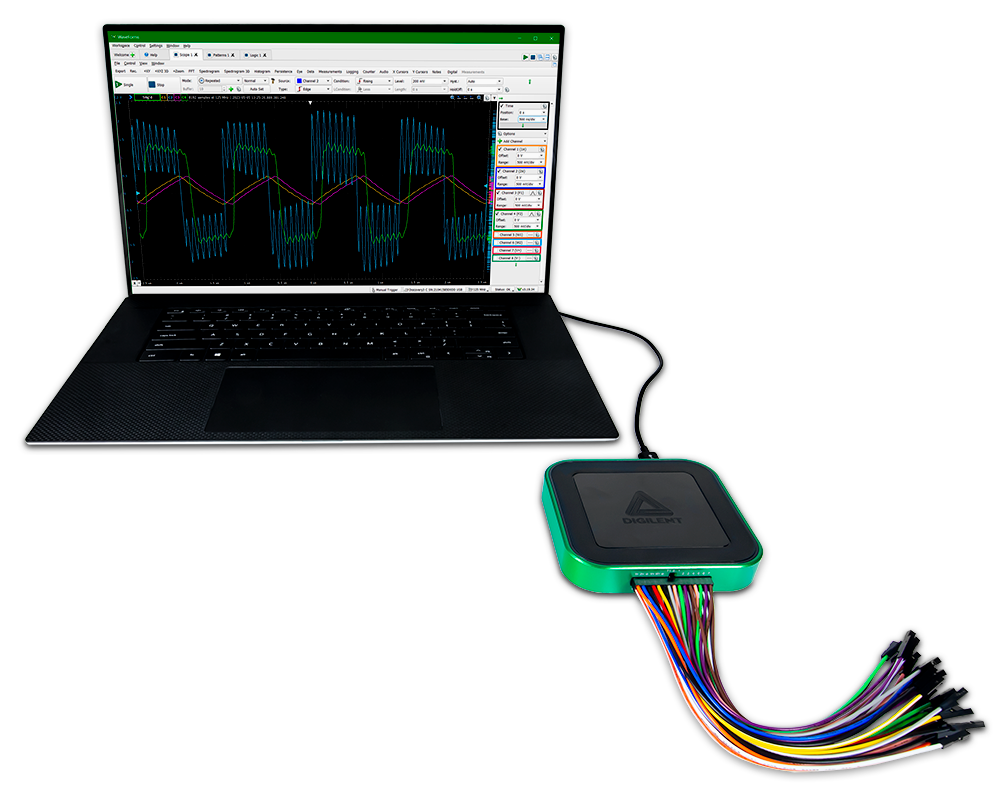Digilent is thrilled to present the Analog Discovery 3, the highly anticipated successor to the acclaimed Analog Discovery 2. Building upon the legacy of its predecessor, the AD3 continues to set a new standard in electronic engineering instrumentation by combining the functionalities of an oscilloscope, arbitrary waveform generator, logic analyzer, pattern generator, and programmable power supplies into a single, compact powerhouse. In this article, we will delve into the enhanced features and advancements of the AD3, showcasing its expanded capabilities and seamless compatibility with the AD2.
Want to learn more about the Analog Discovery 3 in under 350 words? Click HERE

Features
Oscilloscope: Unparalleled Precision and Versatility
The AD3 oscilloscope boasts two differential channels with 14-bit resolution, offering unmatched precision and signal fidelity. With a maximum sampling rate of 125 MS/s per channel and a broad ±25 V input range, the AD3 delivers exceptional performance even in demanding applications. The device offers a bandwidth of over 30 MHz with a BNC Adapter, ensuring accurate measurements across a wide range of frequencies. Additionally, the AD3 provides user-configurable FIR filters and a lock-in amplifier, allowing engineers to extract critical information from complex signals. With features like FFT, Spectrogram, Eye Diagram, and XY Plot views, the AD3 empowers engineers to explore and analyze signals with remarkable depth and clarity.
Arbitrary Waveform Generator: Unleashing Creativity and Flexibility
Featuring two channels with 14-bit resolution and a sampling rate of up to 125 MS/s per channel, the AD3’s arbitrary waveform generator (AWG) provides engineers with unparalleled flexibility. With a ±5 V output range and a bandwidth of 12 MHz (with BNC Adapter), the AD3 AWG allows for the generation of standard and custom waveforms, as well as amplitude and frequency modulated signals. Furthermore, the AD3 supports direct playback from analog inputs and enables the creation of custom waveforms, empowering engineers to unleash their creativity and develop precise and complex signal patterns effortlessly.
Logic Analyzer and Pattern Generator: Comprehensive Digital Analysis
The AD3’s logic analyzer and pattern generator capabilities equip engineers with powerful tools for digital analysis. With 16 digital I/O channels operating at up to 125 MS/s per channel, engineers can capture and analyze digital signals with ease. The AD3 supports individually-configurable 3.3 V digital inputs and outputs, with 5 V tolerant inputs. The device provides extensive protocol support, including SPI, I2C, UART, CAN, JTAG, enabling engineers to interface with a wide range of digital systems. Simple state machines and digital logic are available through the ROM logic within the pattern generator. The AD3’s logic analyzer functionality also extends to custom protocols, ensuring compatibility with diverse application requirements.
Programmable Power Supplies: Enhanced Control and Efficiency
The AD3’s programmable power supplies offer engineers the ability to fine-tune voltage levels with precision. Ranging from 0.5 V to 5 V and -0.5 V to -5 V, these variable power supplies provide versatility for powering various components. When used with an auxiliary power source, the AD3 can deliver up to 800 mA per channel, enabling engineers to meet the power requirements of their designs efficiently.
Additional Features: Expanding Boundaries and Integration
In addition to its core functionalities, the AD3 offers an impressive array of additional features that enhance its versatility and usability. With software instruments such as Spectrum Analyzer, Network Analyzer, Impedance Analyzer, Protocol Analyzer, and Data Logger, engineers gain access to comprehensive analysis capabilities within a single device. The AD3 also includes a voltmeter, in-app scripting capabilities, and virtual digital I/O, allowing engineers to simulate and interact with buttons, switches, and LEDs effortlessly. Furthermore, the AD3 provides an SDK for hardware control in popular programming languages such as C, C++, Python, and more. This enables engineers to integrate the AD3 seamlessly into their existing workflows and customize its functionalities to suit their specific needs.
Audio Adapter+: Expanding Audio Capabilities
The Audio Adapter+ is a module that allows the Analog Discovery 3 to capture and analyze audio signals from external sources and to easily connect audio signals generated by the device to audio devices like headphones and speakers. It is capable of both Mono and Stereo audio for both the Wavegen and Scope instruments. The Audio Adapter+ is equipped with 2×15 MTE connectors, which makes it compatible with both the AD3 and backwards compatible with previous devices in the family. An additional 2×15 MTE connector is loaded as a pass through for the digital signals, power supplies, and others, so that these other instruments can be used simultaneously to support complex applications.
Compatible with the AD2: Effortless Migration
The Analog Discovery 3 shares the same 2×15 header with the Analog Discovery 2. This allows for existing workspaces using the AD2 to be quickly and easily migrated to the AD3 by simply selecting “Yes” when asked if you want to open your old project with the Analog Discovery 3.

Updates to WaveForms
The Analog Discovery 3 isn’t the only thing receiving some TLC; Digilent’s WaveForms software is stepping up its game with a new release to take advantage of the new hardware capabilities. Analog signals to and from the arbitrary waveform generator and oscilloscope on the AD3, ADP3450/3250, and the Eclypse Z7 can be looped back to the other instrument, enabling engineers to view and manipulate the signals with ease.
FIR and IIR filter support has also been added to the 3000-series and Eclypse, giving users multiple options for smoothing out an incoming signal before it reaches the oscilloscope’s acquisition hardware. With multiple windowing functions for FIR and several IIR filters, a wide range of options to clean unstable analog data are at the users fingertips.
WaveForms also now introduces Dual mode for all devices. Sometimes even the four analog input channels on the Analog Discovery Pro (ADP3450) isn’t enough for complex tests. Previously, you had to pull up a second instance of WaveForms, assign the second ADP3450 to that instance, then individually configure the instruments on each device to properly send and receive triggers, all so you could cross compare separate sets of data together afterwards. With dual mode, the hassle is taken away; simply choose your first device, then select your dual second identical device, connect the trigger lines as instructed by WaveForms, and enjoy a unified single view of the two Test and Measurement devices working in tandem.
Record mode for devices has also been upgraded. Previously, the Analog Discovery 2 was limited to a maximum of 1 MS/s while recording analog input data, but with the newest version of WaveForms this has been doubled to 2 MS/s. The Analog Discovery 3 enjoys a five-fold improvement with up to 10 MS/s while recording Scope data. Devices like the ADP3450 and Eclypse Z7 that enjoy built-in DDR memory can now, in addition to the aforementioned faster USB streaming, record data into memory at their maximum sample rates.

Shop Now
The AD3’s capabilities go beyond what we have covered so far, with even more features and functionalities waiting to be explored. Its compact form factor and robust build make it a portable and reliable solution for both benchtop and on-the-go applications. Whether you’re designing, testing, or debugging, the AD3 is a versatile powerhouse that can handle a wide range of tasks with precision and efficiency.
At the time of this writing, Digilent is including a full year of access to our browser-based SPICE simulator, Multisim, and a 30-day free trial to our new datalogging software, EveryMeasure.
For more information, please visit https://digilent.com/.












